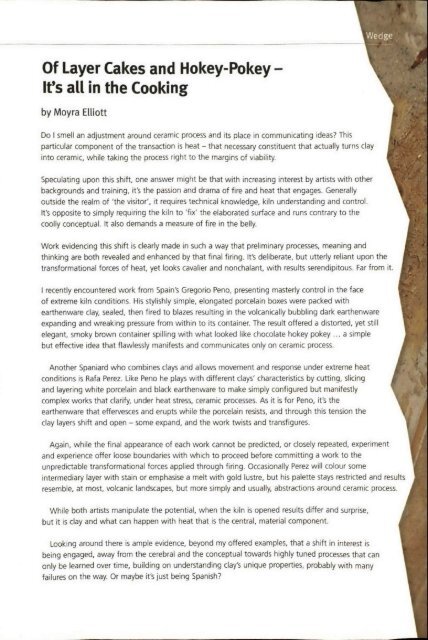The Journal of Australian Ceramics Vol 53 No 2 July 2014
Create successful ePaper yourself
Turn your PDF publications into a flip-book with our unique Google optimized e-Paper software.
Of Layer Cakes and Hokey-Pokey<br />
It's all in the Cooking<br />
by Moyra Elliott<br />
Do I smell an adjustment around ceramic process and its place in communicating ideas? This<br />
particular component <strong>of</strong> the transaction is heat - that necessary constituent that actually turns clay<br />
into ceramic, while taking the process right to the margins <strong>of</strong> viability.<br />
Speculating upon this shift, one answer might be that with increasing interest by artists with other<br />
backgrounds and training, it's the passion and drama <strong>of</strong> fire and heat that engages. Generally<br />
outside the realm <strong>of</strong> 'the visitor', it requires technical knowledge, kiln understanding and control.<br />
It's opposite to simply requiring the kiln to 'fix' the elaborated surface and runs contrary to the<br />
coolly conceptual. It also demands a measure <strong>of</strong> fire in the belly.<br />
Work evidencing this shift is clearly made in such a way that preliminary processes, meaning and<br />
thinking are both revealed and enhanced by that final firing. It's deliberate, but utterly reliant upon the<br />
transformational forces <strong>of</strong> heat, yet looks cavalier and nonchalant, with results serendipitous. Far from it.<br />
I recently encountered work from Spain's Gregorio Peno, presenting masterly control in the face<br />
<strong>of</strong> extreme kiln conditions. His stylishly simple, elongated porcelain boxes were packed with<br />
earthenware clay, sealed, then fired to blazes resulting in the volcanically bubbling dark earthenware<br />
expanding and wreaking pressure from within to its container. <strong>The</strong> result <strong>of</strong>fered a distorted, yet still<br />
elegant, smoky brown container spilling with what looked like chocolate hokey pokey ... a simple<br />
but effective idea that flawlessly manifests and communicates only on ceramic process.<br />
Another Spaniard who combines clays and allows movement and response under extreme heat<br />
conditions is Rafa Perez. like Peno he plays with different clays' characteristics by cutting, slicing<br />
and layering white porcelain and black earthenware to make simply configured but manifestly<br />
complex works that clarify, under heat stress, ceramic processes. As it is for Peno, it's the<br />
earthenware that effervesces and erupts while the porcelain resists, and through this tension the<br />
clay layers shift and open - some expand, and the work twists and transfigures.<br />
Again, while the final appearance <strong>of</strong> each work cannot be predicted, or closely repeated, experiment<br />
and experience <strong>of</strong>fer loose boundaries with which to proceed before committing a work to the<br />
unpredictable transformational forces applied through firing. Occasionally Perez will colour some<br />
intermediary layer with stain or emphasise a melt with gold lustre, but his palette stays restricted and results<br />
resemble, at most, volcanic landscapes, but more simply and usually, abstractions around ceramic process.<br />
While both artists manipulate the potential, when the kiln is opened results differ and surprise,<br />
but it is clay and what can happen with heat that is the central, material component.<br />
Looking around there is ample evidence, beyond my <strong>of</strong>fered examples, that a shift in interest is<br />
being engaged, away from the cerebral and the conceptual towards highly tuned processes that can<br />
only be learned over time, building on understanding clay's unique properties, probably with many<br />
failures on the way. Or maybe it's just being Spanish?

















